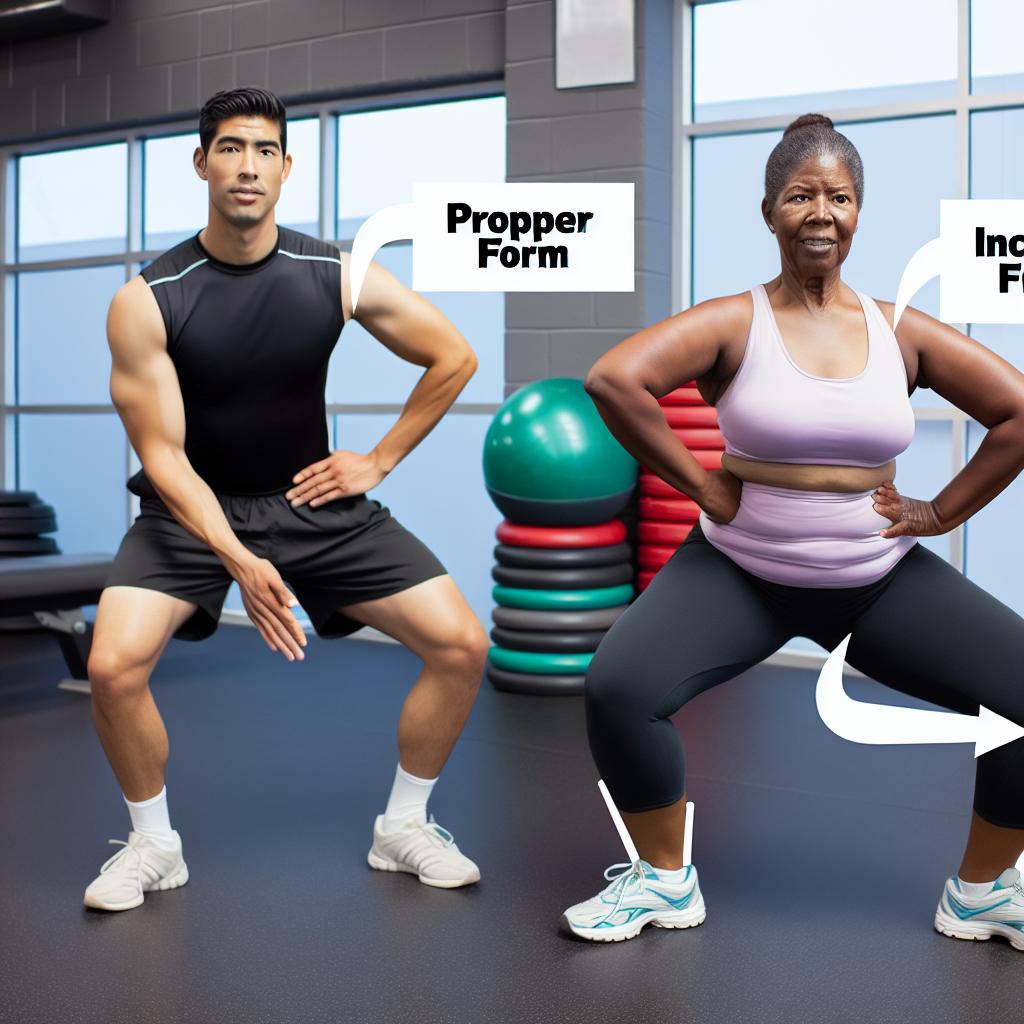Struggling with lower back discomfort can impact your daily life significantly, making it crucial to find effective ways to strengthen this area safely. Engaging in targeted exercises not only alleviates pain but also enhances core stability and overall posture. Discover the best practices to fortify your lower back and embrace a more active, pain-free lifestyle.
## Understanding the Importance of Strengthening Lower Back Muscles
Significance of Lower Back Muscle strength
Strengthening the lower back muscles is essential for a variety of reasons. Not only do these muscles support the spine, but they also play a crucial role in maintaining **proper posture** and providing stability during physical activities. Strong lower back muscles reduce the risk of injuries, notably back pain, which is a common ailment affecting many individuals.
Benefits of a Strong Lower Back
- Enhances athletic performance, particularly in lifts like squats and deadlifts.
- Improves overall core strength, supporting daily activities and exercise.
- Promotes better posture, aligning the spine and reducing strain.
- Reduces the risk of lower back injuries and chronic pain.
Practical Exercises for Strengthening Lower Back
Incorporating targeted exercises can safely strengthen your lower back muscles.Here are simple, effective exercises you can perform at home:
| Exercise | Description | Repetitions |
|---|---|---|
| Bird Dog | Start on hands and knees, extend one leg and the opposite arm, hold for a few seconds, than switch. | 10 per side |
| Bridges | Lie on your back with knees bent, lift your hips, hold for a few seconds, and lower. | 15 |
| Superman | Lie face down, extend arms/legs, raise them off the ground, hold for a moment, then release. | 10-12 |
| Plank | Maintain a push-up position,keeping your body straight,for a set duration. | 30 seconds |
Incorporate these exercises into your routine 2-3 times a week to effectively build strength in your lower back muscles while improving overall stability and posture.
## What Exercises Strengthen Lower Back Muscles safely? Key Considerations
Key Considerations for Lower Back Exercises
when engaging in exercises to strengthen lower back muscles safely, it’s crucial to prioritize proper technique and body mechanics. Adhering to these guidelines can help prevent injury and improve overall effectiveness:
- Warm Up Properly: Always start with a gentle warm-up to increase blood flow to muscles. Consider light cardio or dynamic stretches focused on the lower body.
- Focus on Core Engagement: Strengthening the core is essential for supporting the lower back. Incorporate exercises that engage the abdominal muscles along with back exercises.
- Listen to Your Body: Pay attention to any discomfort. If you experience pain that feels sharp or intense, stop and assess your form or consult a professional.
Effective Exercises for Safe Strengthening
Here are some recommended exercises that can safely strengthen your lower back muscles:
- Bird-Dog: Start on all fours, extend one arm forward and the opposite leg back, maintaining a neutral spine. hold for a few seconds and switch sides.
- Bridges: lie on your back with knees bent, feet flat on the ground. Lift your hips towards the ceiling,squeezing your glutes,then lower back down.
- Cat-Cow Stretch: On all fours, alternate between arching your back (Cat) and dropping your belly while lifting your head (Cow) to enhance versatility.
Tips for Maximizing Safety
To ensure your lower back workout is both safe and effective, consider these additional tips:
- Gradual Progression: Begin with light resistance and gradually increase the weight or difficulty of the exercises as your strength improves.
- Consult a Professional: If you are new to exercise or have pre-existing conditions, consider consulting a physical therapist or fitness trainer for personalized guidance.
- Maintain Optimal Posture: Always focus on maintaining good posture during exercises to avoid needless strain on your back.
## Effective Low-Impact Exercises for Lower Back Strength
Key Low-Impact Exercises for Lower Back Strength
Strengthening your lower back is essential for overall stability and pain relief.Incorporating low-impact exercises into your routine can effectively enhance strength while minimizing strain. Below are several safe and effective exercises that you can easily perform at home or in a gym setting.
1. Bird-Dog Exercise
This exercise improves stability and coordination.
- Start on your hands and knees,keeping your back flat.
- Extend your right arm forward while concurrently extending your left leg backward.
- hold this position for a few seconds, then return to the starting position.
- Repeat on the opposite side.
2. Cat-Cow Stretch
This dynamic stretch increases flexibility and relieves tension.
- Begin on your hands and knees in a tabletop position.
- Inhale as you arch your back (Cow),lifting your head and tailbone.
- Exhale as you round your spine (Cat), tucking your chin and pelvis.
- Continue alternating between these positions for several breaths.
3. Wall Sits
Wall sits strengthen the back and lower body.
- Stand with your back against a wall and walk your feet out a few feet.
- Slowly slide down the wall until your knees are at a 90-degree angle.
- Hold this position for 10-30 seconds, breathing deeply.
Benefits of Low-Impact Exercises for Back Pain Relief
Engaging in low-impact exercises not only strengthens lower back muscles but also enhances overall mobility. These exercises are particularly beneficial for those with existing back pain as they promote healing through gentle movement. The focus on stability and core strength plays a vital role in preventing future injuries.
| Exercise | Description | Duration |
|---|---|---|
| Bird-Dog | Improves coordination and core stability. | 3 sets of 10-15 repetitions |
| cat-Cow stretch | enhances flexibility and releases tension. | 5-10 cycles of breath |
| Wall Sits | Strengthens lower body and back. | 3 sets of 10-30 seconds |
## Step-by-Step guide to Performing Safe Lower Back Exercises
Understanding the Importance of Safe Lower Back Exercises
Engaging in safe lower back exercises is essential for strengthening the muscles that support your spine and preventing injuries. It’s crucial to perform these exercises with proper form and control to maximize benefits while minimizing discomfort. Below is a step-by-step guide to performing effective lower back exercises safely.
Warm-Up Routine
Always start with a warm-up to increase blood flow to your muscles:
- Cat-Cow Stretch: Begin on all fours. Inhale deeply, arch your back (Cow), and exhale, rounding your back (Cat). Repeat for 5-10 breaths.
- Pelvic Tilts: Lie on your back with knees bent. Tighten your abdominal muscles and flatten your lower back against the floor. Hold for a few seconds, then relax. Repeat 10-15 times.
Strengthening Exercises
1. Bird-Dog
To enhance stability and strengthen the core:
- Start on all fours. Extend your right arm and left leg simultaneously, keeping your back straight. Hold for a few seconds.
- Return to the starting position and switch sides. Repeat 8-12 times per side.
2. Bridge
This exercise strengthens the glutes and lower back:
- Lie on your back with knees bent and feet flat. Push through your heels to lift your hips toward the ceiling.
- Hold at the top for a few seconds,then slowly lower back down. Aim for 10-15 repetitions.
3. Knee-to-Chest Stretch
This stretch alleviates tension in the lower back:
- Lie on your back and pull one knee towards your chest while keeping the other foot on the floor.
- Hold for 15-30 seconds, then switch legs. repeat 2-3 times per leg.
Cooldown and Recovery
Finish your workout with gentle stretches to help your muscles relax:
- Child’s Pose: From a kneeling position, sit back onto your heels and stretch your arms forward on the ground. Hold for 30 seconds.
- Seated Forward Bend: Sit with legs extended, reach for your toes, and hold for 15-30 seconds.
Critically important Tips for Safe Practice
- Listen to your body. If you experience pain, stop the exercise.
- maintain proper form to avoid strain on your back.
- Consult a healthcare professional before starting a new exercise program, especially if you have existing back pain.
## Incorporating Stretching for lower Back Muscle Health
Understanding the importance of Stretching
incorporating stretching into your routine is essential for maintaining lower back muscle health. regular stretching helps improve flexibility, enhances blood flow, and reduces the risk of muscle strain.Incorporating stretches into your daily activities not only aids in recovery from lower back pain but also plays a crucial role in preventing future discomfort.
Effective Lower Back Stretches
Here are some recommended stretches that can safely strengthen and promote flexibility in the lower back:
- Child’s Pose: Kneel on the floor, sit back on your heels, and extend your arms forward while lowering your torso to the ground. Hold for 30 seconds.
- Cobra Stretch: Lie face down, place your hands under your shoulders, and gently press upward, arching your back. Hold for 15-30 seconds.
- Knees to Chest: Lie on your back, pull your knees toward your chest, and hug them gently. Hold for 30 seconds.
Incorporating Strengthening Exercises
To further support lower back muscle health, add strengthening exercises to your regimen. These exercises focus on engaging not just the back but also the core and leg muscles,providing a solid foundation for your spine.
Recommended Exercises
Try these safe and effective strengthening exercises:
- Bridges: Lie on your back with knees bent. Lift your hips off the ground while squeezing your glutes. Hold for a few seconds, then lower down. Repeat 10-15 times.
- Pelvic Tilts: Lie on your back with knees bent and feet flat. Tighten your abdominal muscles and press your lower back into the floor. Hold for a few seconds and release.Repeat 10-15 times.
- Dead Bugs: Lie on your back with arms straight up. Lower one arm and the opposite leg toward the floor while keeping your back flat. Alternate sides for 10-15 repetitions.
## Common Mistakes to Avoid When Strengthening Lower Back Muscles
Ignoring proper Form
One of the most common mistakes when strengthening lower back muscles is neglecting proper form. Using incorrect technique can lead to strain and injury. Always focus on maintaining a neutral spine during exercises. For example:
- In exercises like deadlifts, keep the bar close to your body and hinge at the hips to avoid rounding your back.
- During planks, ensure your body forms a straight line from head to heels, avoiding sagging or arching.
Overtraining the Lower Back
Many individuals mistakenly believe that the more they work their lower back, the stronger it will become. Though, overtraining can lead to fatigue and increased risk of injury. To avoid this:
- Incorporate rest days into your routine.
- Allow at least 48 hours of recovery between lower back strength workouts.
- Balance lower back exercises with core and lower body strength training to promote overall stability.
Neglecting Flexibility and Mobility
Strengthening lower back muscles without addressing flexibility can limit your progress. This oversight often results in tight muscles, which can contribute to discomfort. Follow these steps:
Incorporate Stretching
- Include stretches like the child’s pose or cat-cow stretch after your workouts to enhance flexibility.
- consider dynamic stretching before workouts to prepare the muscles.
by avoiding these common mistakes, you’ll foster a safer and more effective strategy for strengthening your lower back muscles.
## Using Proper Form: Techniques for Safe and Effective exercise
Understanding Proper Form
Using proper form is crucial when performing exercises to strengthen your lower back muscles. Maintaining the correct posture not only maximizes the effectiveness of your workout but also minimizes the risk of injury. Here are key points to remember:
- Alignment: keep your spine in a neutral position. Avoid arching or rounding your back during exercises.
- Engagement: Activate your core muscles to provide stability and support to your lower back.
- Movement: execute movements in a slow and controlled manner, focusing on quality over quantity.
Essential Techniques for Safe Exercise
Incorporating safe exercise techniques enhances your overall workout routine. Here are essential techniques to practice:
- warm-up: Always start with a warm-up to prepare your muscles. Simple stretches or light aerobic activity for 5-10 minutes can help.
- Breath control: Breathe deeply and evenly during your exercises. Exhale during exertion (e.g., lifting) and inhale during relaxation (e.g., lowering).
- Use supports: Consider using equipment like stability balls or bands for added support and resistance.
Effective Exercises for Lower Back Strength
Here are some effective exercises you can perform while maintaining proper form:
| Exercise | How to Perform |
|---|---|
| Bridges | Lie on your back with knees bent, feet flat on the ground. Lift your hips toward the ceiling and hold for a few seconds. |
| Bird-Dogs | Kneel on hands and knees, extend one arm forward and the opposite leg back. Hold for a few seconds and switch sides. |
| Cat-Cow Stretch | On all fours, alternate between arching your back (Cat) and lowering your belly (Cow) while looking up. |
Incorporating these exercises will reinforce proper form while effectively strengthening your lower back. Always listen to your body and consult a healthcare professional if you experience pain or discomfort during your workout.
## when to Seek Professional Guidance for Lower Back Strengthening
Recognizing Signs to Seek Help
It’s essential to know when to consult a professional for lower back strengthening. Consider seeking guidance if you experience:
- Persistent Pain: If lower back pain continues for more than a few days despite rest and home care.
- Radiating Pain: Pain that extends down the leg or causes numbness or tingling.
- Severe Discomfort: Intense pain that disrupts daily activities or sleep.
Consulting a Specialist
When symptoms persist, consulting a healthcare provider such as a physical therapist or orthopedic specialist is crucial. They can offer:
- Personalized Assessment: An individualized evaluation of your back pain and functional limitations.
- Customized Exercise Programs: A structured plan focusing on safe exercises tailored to your specific needs.
- Manual Therapy Techniques: Techniques to relieve pain and improve mobility.
Benefits of Professional Guidance
Seeking professional help not only aids in pain management but also helps in strengthening your lower back properly. This results in:
- Improved Technique: Ensuring exercises are performed correctly to avoid injury.
- Progress Tracking: Regular assessments to monitor improvements and adjust exercises.
- Education: Knowledge about body mechanics and posture to prevent future injuries.
## Additional Tips and Remedies for Lower Back Muscle Wellness
Incorporating Regular Movement
To maintain lower back muscle wellness, it is essential to incorporate regular movement into your daily routine.Aim to take breaks from prolonged sitting by standing up and stretching every 30 minutes. Consider these strategies:
- Perform gentle stretches such as the cat-cow pose or child’s pose.
- Engage in light walking,which can aid in circulation and decrease stiffness.
- Utilize a standing desk or take calls while walking to minimize sedentary time.
Strengthening Exercises
Strengthening the muscles surrounding your lower back is critical for supporting spinal health. Here are a few effective exercises:
Bird-Dog
- Position yourself on all fours, ensuring your hands are beneath your shoulders and knees beneath your hips.
- Extend your right arm forward and your left leg back, keeping your body straight.
- Hold for a few seconds, then return to the starting position.
- Switch sides and repeat for 10-15 repetitions.
Bridges
- Lie on your back with your knees bent and feet flat on the floor.
- Engage your core and glute muscles, then lift your hips toward the ceiling.
- Hold the position for 5 seconds, then lower back down.
- Repeat for 10-15 repetitions.
Stretching Techniques
Incorporating stretching into your routine can enhance flexibility and alleviate tightness in your lower back. Consider these stretches:
- **Hamstring Stretch**: Sit on the floor with one leg extended. Reach toward your toes, holding for 15-30 seconds.
- **Seated Twist**: While seated, twist your torso towards one side, holding for 15-30 seconds before switching sides.

Q&A
### What are the best exercises for strengthening lower back muscles safely?
To strengthen your lower back safely, consider incorporating a variety of low-impact exercises that target the core, glutes, and spinal-supporting muscles. Here are some highly recommended ones:
- **Pelvic Tilts**: Begin by lying on your back with your knees bent and feet flat on the floor. Gently flatten your lower back against the floor by tilting your pelvis upward. Hold for a few seconds before relaxing. Repeat 10-15 times.
– **Cat-Cow Stretch**: Start on your hands and knees in a tabletop position.Arch your back toward the ceiling (cat) and then dip it toward the floor while lifting your head and tailbone (cow).This dynamic movement helps improve flexibility and relieves tension.
– **Bird-Dog**: from the same tabletop position, extend one arm forward and the opposite leg back. hold for a few seconds, then switch sides. This exercise enhances stability and works on coordination.
### How frequently enough should I perform lower back strengthening exercises?
For optimal results, aim to incorporate lower back strengthening exercises into your routine **three to four times a week**. Consistency is key in building strength and enhancing stability. Here are some tips for effective workouts:
- **Warm Up**: Always start with a warm-up to prepare your muscles.Simple movements like walking or dynamic stretches can help to increase blood flow.- **Set Goals**: Focus on a modular approach – perform 2-3 sets of each exercise,gradually increasing repetitions as your strength improves.
– **listen to Your Body**: if you experience any discomfort or pain, it’s important to stop and assess your form. Avoid pushing through pain as this can lead to injury.
### Can I do lower back exercises if I currently have pain?
If you’re experiencing lower back pain, it’s crucial to approach exercises with caution. **Gentle stretching and low-impact workouts** can often help alleviate discomfort, but you should consult a healthcare professional before starting any new routine.
Here’s a breakdown of safe practices during this time:
– **Focus on Stretching**: Many individuals find relief through stretches such as the **child’s pose** or **hamstring stretch**. These can provide gentle relief to the lower back.
– **Gradual Strengthening**: Start with basic movements like **bridges**, where you lie on your back with knees bent and lift your hips towards the ceiling, promoting stability without overstraining the back.- **Monitor Pain Levels**: Always pay attention to how your body feels during and after workouts. Discontinue any exercise that exacerbates your pain.
### What role does core strength play in lower back health?
Core strength is integral to overall back health as a strong core provides stability and support for the spine. The muscles located in the abdomen, hips, and lower back work together to help maintain proper alignment and posture, which can reduce the risk of injury.
Here’s how you can elevate your core strength:
– **Incorporate Core exercises**: Focus on exercises like **planks**, which engage multiple core muscles and promote good posture.
– **Balanced Routine**: Include aerobic activities and flexibility training,such as yoga or Pilates,to enhance core engagement and spinal support.
– **Functional Movements**: Consider movements that mimic everyday activities (e.g., squats or deadlifts) under appropriate guidance, ensuring your core remains activated.
### Are there any precautions I should take when exercising my lower back?
Yes, safety should always be a priority when performing exercises aimed at strengthening the lower back. Here are several precautions to take:
– **Warm-up**: As mentioned earlier, a warm-up is essential to avoid injuries.Prioritize dynamic stretches and movements related to your workout.
– **Use Proper Form**: Focus on maintaining good body mechanics to prevent strain. Engage your abdominal muscles and avoid excessive arching or twisting of your body while performing exercises.
– **Avoid High-Impact Activities**: Exercises that involve high impact or heavy lifting, especially if you’re new to back strengthening, can exacerbate issues. Stick with low-impact workouts like swimming or cycling until you build more strength.
### how long will it take to see results from lower back exercises?
the timeline for seeing results from lower back exercises can vary significantly based on several factors, including your initial fitness level, frequency of workouts, and consistency with the regimen. Generally, **improvements can be noticeable in 4-6 weeks** if you adhere to a structured program.To maximize results, consider the following:
– **stay Consistent**: consistency in your exercise routine is crucial. Try to stick to a schedule, as regular practice helps build strength and endurance.
– **Combine with Other Health Practices**: Pair your exercise plan with a balanced diet and proper hydration to support muscle recovery and overall health.
– **Track Progress**: Keeping a log of your workouts can motivate you and help you see progress.Consider noting how you feel before and after workouts to gauge improvements in strength and comfort.
By following these guidelines and staying committed to your routine,you can safely strengthen your lower back and improve your overall health.
To Wrap It Up
## Conclusion: Strengthening Your Lower Back Safely
By incorporating specific exercises into your routine, you can effectively strengthen your lower back muscles while ensuring safety and minimizing discomfort. Remember, a strong lower back supports your overall health and well-being.
### Key Takeaways:
– **Consistency is key**: Make it a habit to perform these exercises regularly. Aim for at least 15 minutes a day to see noticeable improvements.
- **Listen to Your Body**: Pay attention to how your body responds. If you feel pain (beyond normal muscle fatigue), stop and reassess your technique or consult a professional.
– **Warm-Up**: Always include a warm-up before starting your exercises to prepare your muscles and reduce the risk of injury.
– **Cool Down**: Incorporate gentle stretching post-exercise to promote flexibility and blood flow.
### Recommended Exercises:
– **Bridges**: Target glutes, hamstrings, and lower back effectively.
– **Cat-Cow Stretches**: enhance flexibility and relieve tension.
- **Bird-Dog**: Improve balance and core stability.
Engaging in these exercises can foster a healthier back, leading to a more active lifestyle. Start today, and remember, your journey to a stronger lower back is just a few exercises away! For more in-depth guidance on lower back strengthening, explore resources from trusted organizations like the Mayo Clinic and British Heart Foundation[[1]](https://www.mayoclinic.org/healthy-lifestyle/adult-health/in-depth/back-pain/art-20546859)[[3]](https://www.bhf.org.uk/informationsupport/heart-matters-magazine/activity/exercises-for-lower-back-pain).











